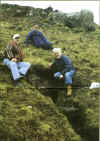|
Covenanter sites and monuments.
April 2002
seems to have been a fruitful month for the discovery of
Covenanter sites and monuments. In Gourock a spring
called the Covenanter`s or White`s Well has been
discovered; and in Dumfries some original monumental
stones, almost certainly the work of Robert Paterson –
`Old Mortality`, have been retrieved from the shrubbery.
The Covenanter`s or White`s Well, Gourock.
My thanks to the Greenock Telegraph
for permission to use their article.
 A A
report in the Greenock Telegraph of 20 April tells of how
local men, Hector Crawford, Sam Morrell, Stewart McArthur
and Alistair Morrell, followed up on a cryptic entry
on a map that indicated a `Covenanter`s or Whites Well`
located on the edge of town. The well is off
Earnhill Road, near the Larkfield Industrial Estate and
about quarter of a mile south -west of Gourock Cemetery.
The map reference NS 2342 7623.
The site
and stories associated with it had been known to the men
for many years but they followed up by excavating
around the edges of a spring that was seeping from the
ground. To their astonishment and delight they
uncovered a substantial rock that was engraved with
the words “Whites Well ” and the year 1698. There are
several other designs and inscriptions, and the
letters B O M.
Complementing the site is a large rock outcrop a few yards
up the hill from the spring known locally as the `Pulpit
Rock`. The general lie of the land is well suited for
holding clandestine meetings or conventicles. Local lore,
supported by archaeologists and other bodies, is that the
site was used by the Covenanters for prayer meetings and
it is thought likely that the well may have been used for
christenings.
The Royal
Commission on Ancient and Historical Monuments of Scotland
are explicit in saying that coventicles were held here and
that, sadly, it has suffered the modern blight of
vandalism. There was a natural `book board` or lectern on
the Pulpit Rock and two steps behind it giving
easier access which have disappeared since 1947, along
with many incised markings. The site is currently being
further investigated by Historic Scotland and the
Inverclyde museums department.
The date
1698 is rather confusing unless it was placed there as a
commemorative date of events then past. The Church of
Scotland was `by law established` in 1690 and
Presbyterianism became the approved Church. Thus after
1690 there was no absolute need to hold open air
conventicles. However, there were the Society
People, or `Cameronians` (followers of Richard Cameron
killed in 1680 and James Renwick executed in 1688)
who remained outside the newly established church. It is
likely that these dissenters – `the faithful remnant` ,
continued with outdoor gatherings for a while through
necessity, not having fixed churches of their own.
There is also the custom and practice of the people in the
locality who probably enjoyed the large prayer gatherings
and continued to do so for some years after the Glorious
Revolution. It would not be the first occasion – nearly
three hundred and fifty years after the battle in 1666,
there is still a conventicle held at Rullion Green, in the
Pentland Hills.
Evidence of
earlier conventicling in the top end of Renfrewshire
is limited but it certainly took place. When the
ministers were outed in 1663 there were but two who
conformed in Renfrewshire and many curates were appointed
to the vacancies. Some were good men but others were
despised for their mean and sometimes scurrilous
behaviour. From this there developed a reluctance to
attend church and eventually a concern expressed to
the Synod and Archbishop of Glasgow by the curates
because their income was negligible. In his
History of Renfrew William Metcalfe quotes
Wodrow that ” In many places they had twenty miles to run
before they heard a sermon or got the spiritual manna,
…” so great were the numbers that some [ of the outed
ministers ] were constrained to preach without doors
and at length to go to open fields .” Thus
conventicles were born. Metcalfe specifically cites the
Presbytery records and the case of the Sheriff who
was reported to the Archbishop of Glasgow in December 1674
for not doing more about the conventicles
” as also
anent Mr Cunningham`s conventicling in Greenock and
Inverkip “.
As for the
name, White might have been the name of a Covenanter
preacher or
perhaps simply the owner of the land. Research in the
Session and Paisley Presbytery records might clarify this,
or the Fasti of Church of Scotland ministers might reveal
a possible candidate. The Cameronians had three ministers
– Lining, Boyd and Shields who were ordained but in the
1690 settlement all three returned to the Church of
Scotland. Thus the Society people were without a minister
until the arrival of the Rev John MacMillan in 1706. In
these circumstances their meetings would have been for
prayer and fellowship. The sacrament of baptism could only
properly have been conducted by an ordained minister,
which implies that baptisms at the well would have taken
place in the pre Revolution period, as after 1690 the
established church was available. But a local minister may
have gone to the well after 1690 by special request. The
important thing is that the site and the reasons why it
was used for conventicles are preserved.
Next:
Old Mortality stones.
|